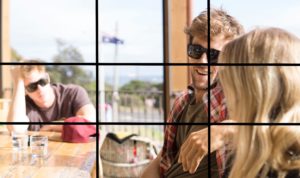How to Select the Perfect Social Media Photo
- By ramin
- October 26, 2020
- 8:29 pm

How to Select the Perfect Social Media Photo
Since everybody’s got a camera in the back of their pocket, it seems like we’d all be great photographers — but oftentimes, the photos we see on social media are dimly lit, poorly shot, and some are just plain old ugly.
If you want people to interact with you in a positive manner, view you as a professional, and keep coming back to your pages and platforms for more, you’ll want to choose photos that are well crafted, balanced, and beautiful.
But don’t let that stress you out! We’ve outlined some simple steps so you can understand how to choose the perfect photo to share on social.
Step 1: Understanding the Basics
Rule of Thirds
You know a good photo when you see one — but did you know there’s a set of rules you can follow that shows why that photo looks so great?
That’s right — the rule of thirds!
The rule of thirds is essentially just a guideline that proposes that an image should be divided into nine equal parts by equally spaced horizontal and vertical lines with the focal point of the photo landing on the intersection of said lines.
Confusing? Here’s a picture to help you out:

See how the focal point — the man’s face — lines up perfectly with the intersection in the top right-hand corner?
Studies have shown that when viewing images, our eyes naturally fall along these points of intersection — not in the middle like you might expect. By placing your focal points along these intersections, you create balance, flow, and allow your viewer to interact with your photo more organically.
For best results, identify the main points you want to include in your photo and where you want to place them. Some cameras and cell phones even have a rule-of-thirds grid that you can display on screen when setting up your shot, but you can also always fine tune things afterwards, as many photo-editing tools will have an option to display this grid, too.
One of the best things about digital photography is that you can take hundreds of shots in mere minutes, which leaves lots of room for experimentation — and rule breaking!
Yes, it’s okay for you to break the rule of thirds. There are tons of striking photos out there that are centered and symmetrical that don’t employ the use of the rule of thirds! However, if you’re looking for a simple and easy way to get started on understanding what goes into a good photo, give the rule of thirds a try.
Contrast & Color
Contrast is essentially just the separation between the darkest and lightest areas of the photo. By increasing the contrast, you increase the separation between dark and light, making the darks darker and the lights lighter. By decreasing it, you do the opposite, making them more similar in shade.
Here’s a photo to help explain:
(high contrast)

(low contrast)

See how much more dramatic the photo on the right looks compared to the photo on the left? And the one on the left, how everything looks more flat and gray in comparison?
Experts say that photos with a higher contrast and lots of color catch the attention of social media users more quickly and easily than photos with a lower contrast that carry a more “grayscale” look.
But be careful! Including too many contrasting colors can make your photo appear busy, confusing, and harsh on the eyes, which can drive viewers away. Instead, it’s better to choose a few colors that pop alongside some calmer ones so everything works in harmony.
This should be enough for you to get the ball rolling, but if you’re looking for more details on color and how it relates to social media, you can head to this great article!
Foreground, Middleground, Background
Lastly, in order to create the perfect photo, you’ll want to show a depth of field with a clear foreground, middleground, and background.
Depth of field is defined as the distance between the closest and farthest objects in a photo. A camera can only focus on one point sharply, and the transition from sharp to soft is what creates a depth of field.
See how this image clearly shows the depth of field, a clear distinction between foreground, middleground, and background, and one focal point?
When applying this to your social pics, sometimes you’ll want to show a deep depth of field — like if you’re trying to isolate one particular subject in a busy room or if you’re photographing a product or person. Other times, however, if you’re trying to show several subjects at once, like an Instagram flatlay of multiple products or a group photo, you’ll want to decrease the depth of field and keep everything sharp and in focus.
The biggest thing to take away is that while there are definitely some rules of thumb you can follow, you’re more than free to break them by experimenting with different tactics, angles, light sources, contrasts, colors, depths of field, and more.
But don’t let this scare you off — let the possibilities of all the amazing photos you’ll take spark your passion, take lots of photos and try new things, and most of all, have fun with it!
Step 2: Tying Content to Copy
Now that you’ve read this blog and learned how to take thousands of perfect photos, you’ve gotta get them ready to rock the social media world.
Whatever image you choose to post, one final tip is that your caption must relate to the image in some way, shape, or form. Captions give your viewers context and provide relevant information and value, and if you don’t tie your words to your image, you’ll confuse your viewers and cause them to unfollow you.
But it’s easy to do this!
Don’t post a photo of a puppy and write a caption like, “Sale, 50 percent off, today only.”
Post a photo of a puppy and say something like, “Our furry friend is paws-itively delighted by all the awesome things he picked up today at our 50-percent-off sale! Come on down to say hi, grab some goodies, and maybe give him a belly rub or two.”
By tailoring your fantastic photos to informative, strong, and fun copy, you’ll begin to form the building blocks of a social media marketing plan that’ll grow your company to new heights.
And if you need a fellow bricklayer to lend a hand, we’d be happy to be the ones to have your back. Don’t hesitate to get in touch with us if you’ve got any questions!

8863 Anderson Mill Road, Suite 117
Austin, Texas
78729
© 2019 Optictour. Trademarks and brands are the property of their respective owners.
Google and the Google logo or any other related screenshots are registered trademarks of Google LLC, used with permission.
